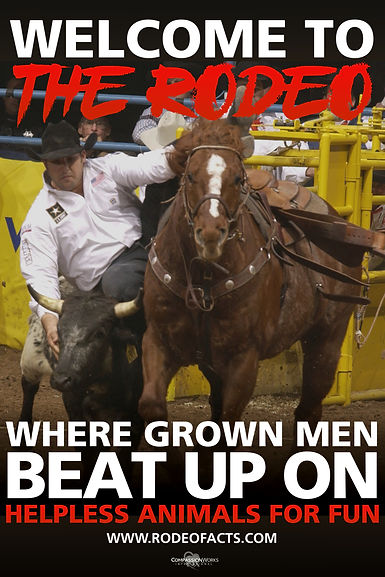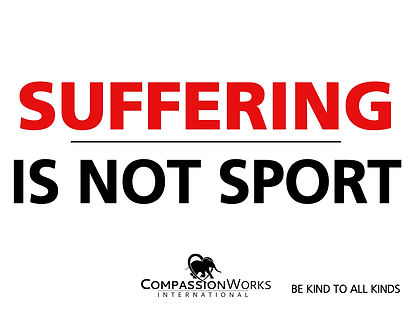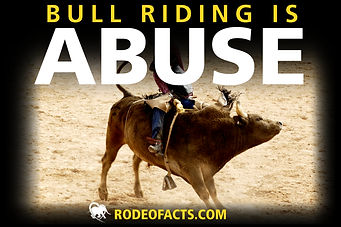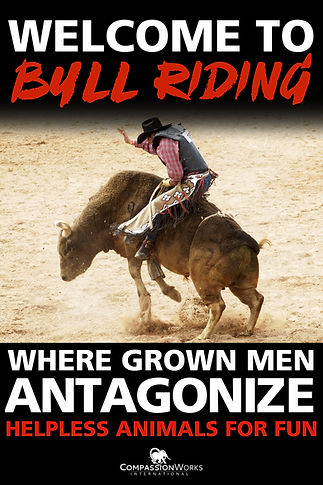




Don't believe their lies.
Proponents of the rodeo would have you believe it is a traditional sport that is not harmful to animals. They claim "animal welfare" is a "matter of course".
However, the modern rodeo is a cruel "sport" that unnecessarily traumatizes and torments animals and results in their suffering, pain, and even death.

History

The Rodeo: from ranch work to "sport"
The modern rodeo is based on the activities found on early ranches dating back to the 1700s, and included roping, horse breaking, riding, herding, branding, and much more. As the westward expansion of the U.S. gained force, the cattle business boomed. Long cattle drives designed to bring cattle to the stockyards ended in these new "cowboys" holding informal competitions among themselves to determine which group had the best riders, ropers, and all-around best drovers. These early competions were the first known "rodeos".
Ultimately the expansion of the railroads and the introduction of barbed wire eliminated the need for long cattle drives, and range lands were divided amongst the increasing population of homesteaders and settlers. Along with the decline of the open West, demand for the cowboy’s labor began to dwindle so many cowboys began to take jobs with a new American phenomenon, the Wild West Show.
These shows were partly theater and partly competition and were focused on making money and glamorizing and preserving the disappearing American frontier. Today rodeo competitors still call rodeos ‘shows’ and they participate in ‘performances’. At the same time, other cowboys were supplementing their income at their usual informal competitions, which were now being held in front of paying spectators. Small towns across the frontier would hold annual stock horse shows, known as 'rodeos', or ‘gatherings’. Cowboys would often travel to these gatherings and put on what would be known then as ‘Cowboy Competitions’.
Of these two types of shows only the cowboy competitions would survive. Eventually Wild West Shows began to die out due to high costs of mounting them and many producers begin strictly producing the less expensive cowboy competitions at local rodeos, or stock horse shows. Spectators would now pay to see the competitions and cowboys would pay to compete, with their money going into the prize pool. Many towns began to organize and promote their local rodeo, just as they do today. In frontier towns like Cheyenne, Wyoming, and Prescott, Arizona the rodeo became the most anticipated event of the year.
With the disappearing lifestyle of the western frontier, the popularity of rodeo grew, and rodeos began to spread across the country. Cowboys who had been facing grim financial prospects could now travel and make a living by rodeo alone, giving rise to the professional rodeo competitor.
Many of the major rodeo committees from larger rodeos came together in 1929 to cement uniform rules of competition under the umbrella of the Rodeo Association of America (RAA). Yet while it had become possible to document and determine champions in each event, promoters often took advantage of the cowboys, judging was uneven, and prize money often turned out less than agreed upon.
In 1936, a group of roughly 60 cowboys at the Boston Garden Rodeo became angry over a promoters refusal to advertise the rodeo and to add their entry fees to the prize money. They decided to stage a walk-out and refused to compete, which resulted in their requests being granted. These cowboys then formed the Cowboy Turtles Association and ultimately became the Rodeo Cowboys Association in 1945.
The Rodeo Cowboys Association changed their name to the Professional Rodeo Cowboys Association in 1975 and remains the largest sanctioning body of rodeo in the United States and Canada. The National Finals Rodeo, the culmination of the PRCA’s rodeo year, is held each year in Las Vegas, Nevada.
Abuse

Despite being riddled with the animal cruelties detailed below, the rodeo is frequently regarded as a traditional sport and is the official state sport of Wyoming, South Dakota, and Texas. Yet as a culture we have moved beyond many other injustices that were once regarded as "tradition", and now the time has come to raise awareness about and put an end to rodeo cruelty.
While the erratic behavior of the animals in rodeos may seem “entertaining” to the audience and make the cowboys appear impressive, it is nothing more than fear. The animals experience panic, pain, and high levels of anxiety prior to their "performances." Rodeos intentionally cause these reactions in the animals to rile the crowd and make the the event more "entertaining". The tools used to incite the animals can include the “hotshot,” an electric prod used to cause intense pain which scares the animal into displaying abnormally dramatic reactions, and metal spurs and “bucking straps” that burn the animal’s abdomen and groin area and cause him to “buck”, which can lead to back and leg injuries.
Rodeo events are animal abuse.
-
Calf Roping: This event makes use of 3-4 month old calves who are tormented and shocked while in the "shute" or holding pen. When released, the calf frantically tries to escape torture by running out into the ring. A mounted rider then lassoes the calf, yanking the baby into the air by his neck, slamming him into the ground, and finally proceeds to tie his legs together thus immobilizing the animal. During this event, calves may cry out (if they can breathe), defecate from fear and stress, suffer neck and back injuries, may become paralyzed, suffer from internal hemorrhaging, have their tracheas severed, or die.
-
Steer Busting (aka steer tripping): A rider ropes a provoked steer with such force that the animal flips in the air. The injury and death rate is so high the Nevada State Veterinarian forbids it from the National Finals Rodeo, but this is easily bypassed by holding the event in other locations. During this event, steers have their heads and necks violently jerked and twisted, frequently causing neck and back injuries, fractured horns, hip sores and death.
-
Steer Wrestling: The contestant, mounted on a horse, chases a steer out of the holding chute. He grabs the steer’s horns while dismounting, twists the animal’s neck, and slams him to the ground. During this event, the animals can suffer broken bones and necks, torn ligaments, severed spinal cords and trachaes, suffer from internal bleeding, or die.
-
Bull Riding and Saddle Bronc Riding: The “flank” is the area of the animal’s body behind his rib cage. An adjustable belt called a “bucking strap” or “flank strap” is placed around the horse’s flank. The contestant tightens the belt, which pinches the animal’s groin and genitals, causing him to buck from the pain. The contestant also spurs the horse. During this event, ANIMALS ARE TORTURED WHILE RIDERS TRY TO HANG ON AS THE ANIMALS BUCK IN ANGUISH.
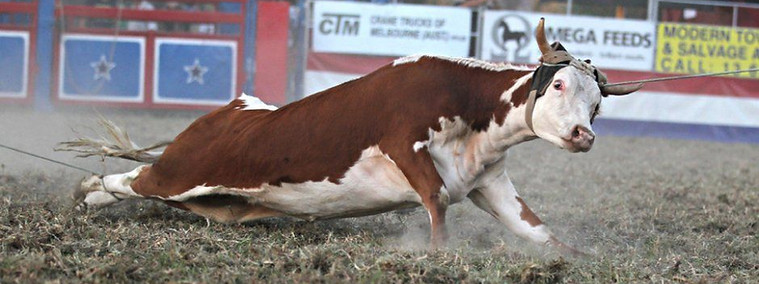
There is no "humane" rodeo.
Rodeos are constant trauma for the animals forced to participate. They suffer broken ribs, backs, and legs, torn tails, punctured lungs, internal organ damage, ripped tendons, torn ligaments, snapped necks, and suffer agonizing deaths. It is an inescapable fact that the rodeo, which torments animals for amusement, thrives on blatant animal abuse.
This abuse begins even prior to their arrival in the ring. The animals doomed to participate are transported in overcrowded trucks and trailers, and they may be confined for as long as 24 hours without being properly fed or watered, according to the “rules” of the Professional Rodeo Cowboys Association (PRCA). Ropers are allowed to cripple as many as 3-4 animals a day while practicing for their “performance.”
After being tortured, almost all rodeo animals end up at the slaughterhouse.
Despite increased publicity about animal cruelty, the PRCA has not has not improved animal safety. The penalties for violating regulations are not severe enough to deter abuse and are miniscule in comparison with the large rodeo cash prizes at stake.
THE ONLY RODEO THAT IS SAFE FOR ANIMALS IS NO RODEO AT ALL. Fight the rodeo in your community today and say no to an industry that profits off of the lives and suffering of innocent animals.
Take Action
You can help put an end to rodeo abuse!
-
Never attend a rodeo.
-
Protest the rodeo when it comes to your city or town. For more information on how to hold a protest, visit our protesting guide. For free downloadable protesting materials like posters and leaflets, see below.
-
If you are able, consider capturing images of the animals used by the rodeo. Please contact us for assistance.
-
Have conversations with, boycott, and/or petition rodeo sponsors and venues, and request they do not support animal cruelty.
-
Talk to family and friends and discourage them from going to the rodeo.
-
Spread awareness of rodeo cruelty via your social media channels.
-
Work to pass legislation in your community or state. Open dialogues with local decision makers.
-
Be aware of existing legislation and make sure rodeos are following the rules. A list of current state laws is available here.



